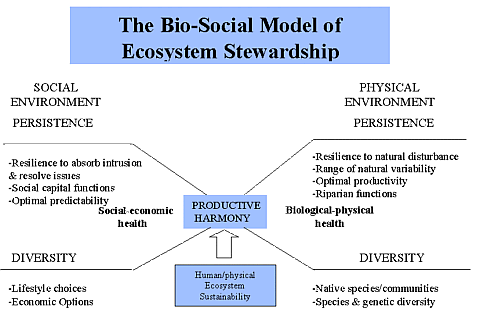Productive Harmony
Productive Harmony describes the related concepts of physical and social environmental health as introduced and developed in the National Environmental Policy Act of 1969 (NEPA), Section 101:
"…environmental decisions and actions shall be made in ways that "create and maintain conditions under which man and nature can exist in productive harmony, and fulfill the social, economic, and other requirements of present and future generations of Americans."
Section 102 of NEPA contains the procedural requirements for carrying out an Environmental Assessment (EA) or an Environmental Impact Statement (EIS) and has received the most attention over the years. It is Section 101 that contains the policy intent of Congress for Productive Harmony, a means by which to make NEPA become a collaborative tool for natural resource decision-making.
The Environmental Justice requirement, in conjunction with Section 101 of the National Environmental Policy Act (NEPA) of 1969, is a powerful tool to protect minority and low-income people from being exploited. JKA has developed The Discovery Process™ and the Kent Issue Management System to effectively address the requirements of NEPA and Environmental Justice.
At Natural Borders, we define productive harmony as a healthy, balanced state of a bio-social environment where both social and physical resources have high levels of permanence and diversity, enabling their sustainability.
 Social resources are the people found in a culturally-defined geographic area, including their survival networks and their self-described boundaries around various living patterns and activities. Social resources are measured or described by a process of onsite inspection and research that results in an inventory of Cultural Descriptors.
Social resources are the people found in a culturally-defined geographic area, including their survival networks and their self-described boundaries around various living patterns and activities. Social resources are measured or described by a process of onsite inspection and research that results in an inventory of Cultural Descriptors.
Permanence of social resources includes people's sense of stability coupled with their ability to participate in, predict, and control events affecting their lives and the lives of their children, neighbors and kin.
Diversity in the context of social resources refers to the range of options people have open to them in a human-geographic unit for social, cultural, and economic activities: With whom to associate (networks), where to live (settlement), how to earn a living (work), how to get and give help (support services), and where and how to have fun (recreation).
 Physical resources include all the natural and biological attributes of a given geographic area, except the people. Such resources may be renewable (timber, wildlife, water, solar energy) or non-renewable (minerals, fossil fuels), and are measured or described by a process of secondary research coupled with onsite inspection.
Physical resources include all the natural and biological attributes of a given geographic area, except the people. Such resources may be renewable (timber, wildlife, water, solar energy) or non-renewable (minerals, fossil fuels), and are measured or described by a process of secondary research coupled with onsite inspection.
Permanence of physical resources means that the yield of both renewable and non-renewable resources will continue well into the future.
Diversity in the context of physical resources is the variety and variability of natural resources that are interdependent in a systematic way (habitat continuum) such that each affects the viability of all other components.
From a resource management perspective, productive harmony is achieved when actions affecting the total environment are reasonably judged to increase permanence and diversity in the long run. This end can be achieved when diversity and permanence are recovered, enhanced, and sustained through integrating both the social and physical arenas. We call this integration a bio-social ecosystem. The process of implementing and sustaining productive involves Issue Management.
Cobalt Web Designs